One of the landscape tree production practices that drives me absolutely nuts is heading back trees in the nursery to create “columnar” specimens. It’s easy to find examples of these in Washington state nurseries, like the pathetic oak shown below:
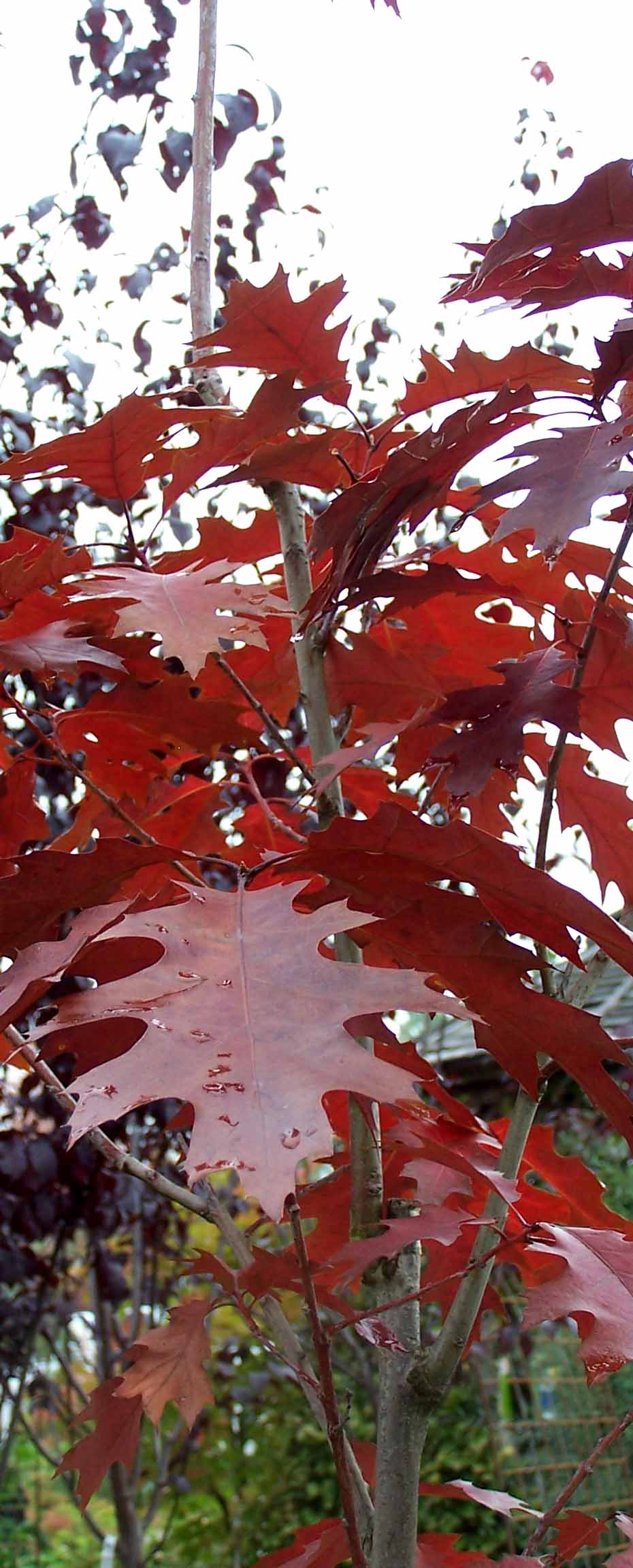
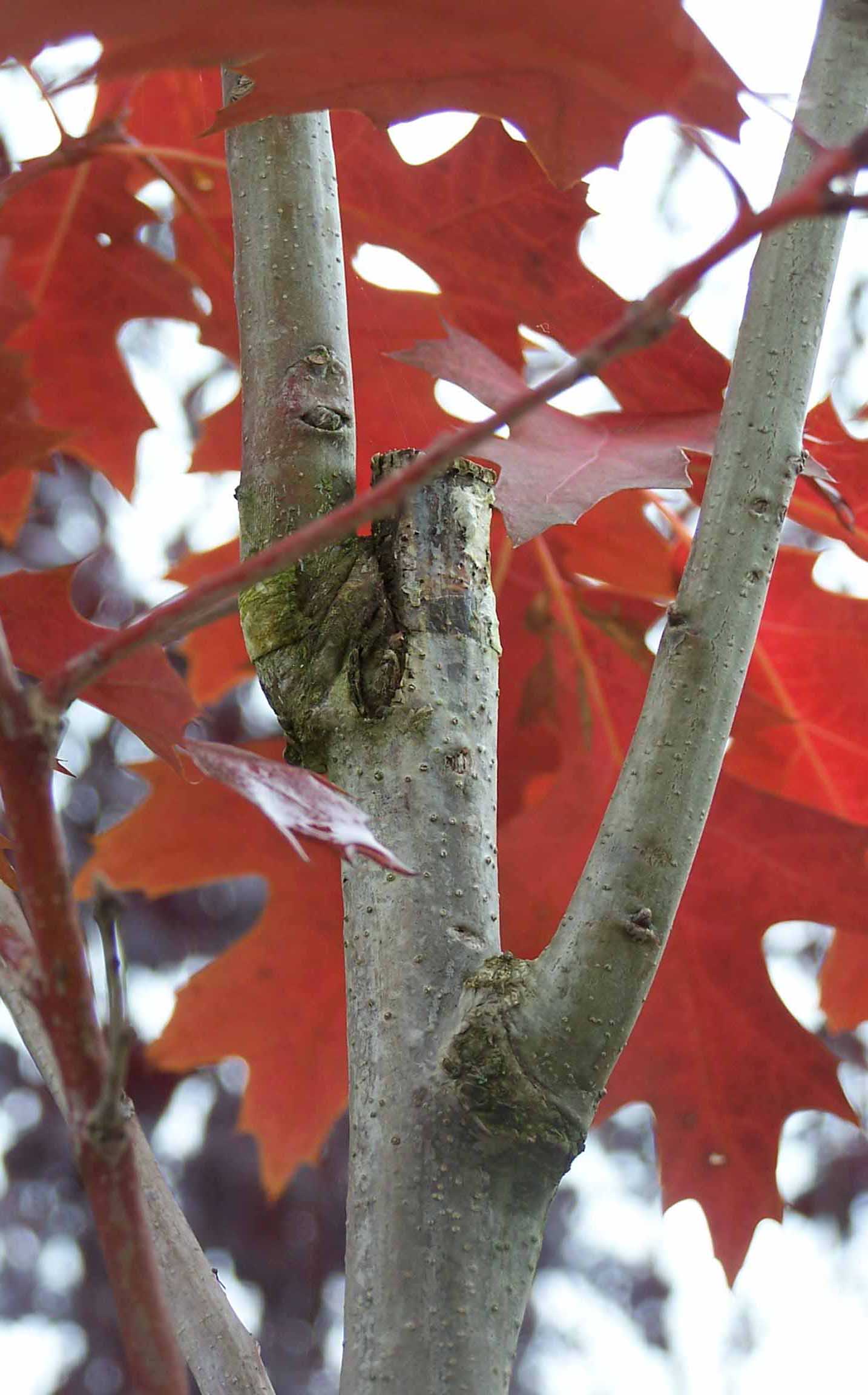
Aesthetics aside, let’s focus on how the tree responds to heading back. The removal of the dominant leader encourages lateral branches below to become more upright; from these laterals, a new leader is selected. This new upright growth habit is highly prized by many landscape architects and urban planners, as such trees fit more neatly into small urban spaces without interfering with vehicle and pedestrian traffic. Sure, it works great for a few years.
Now let’s look at these trees a decade or two later. Branches grow in diameter as well as length. All of these acutely angled branches begin to grow into each other, creating bark inclusions:
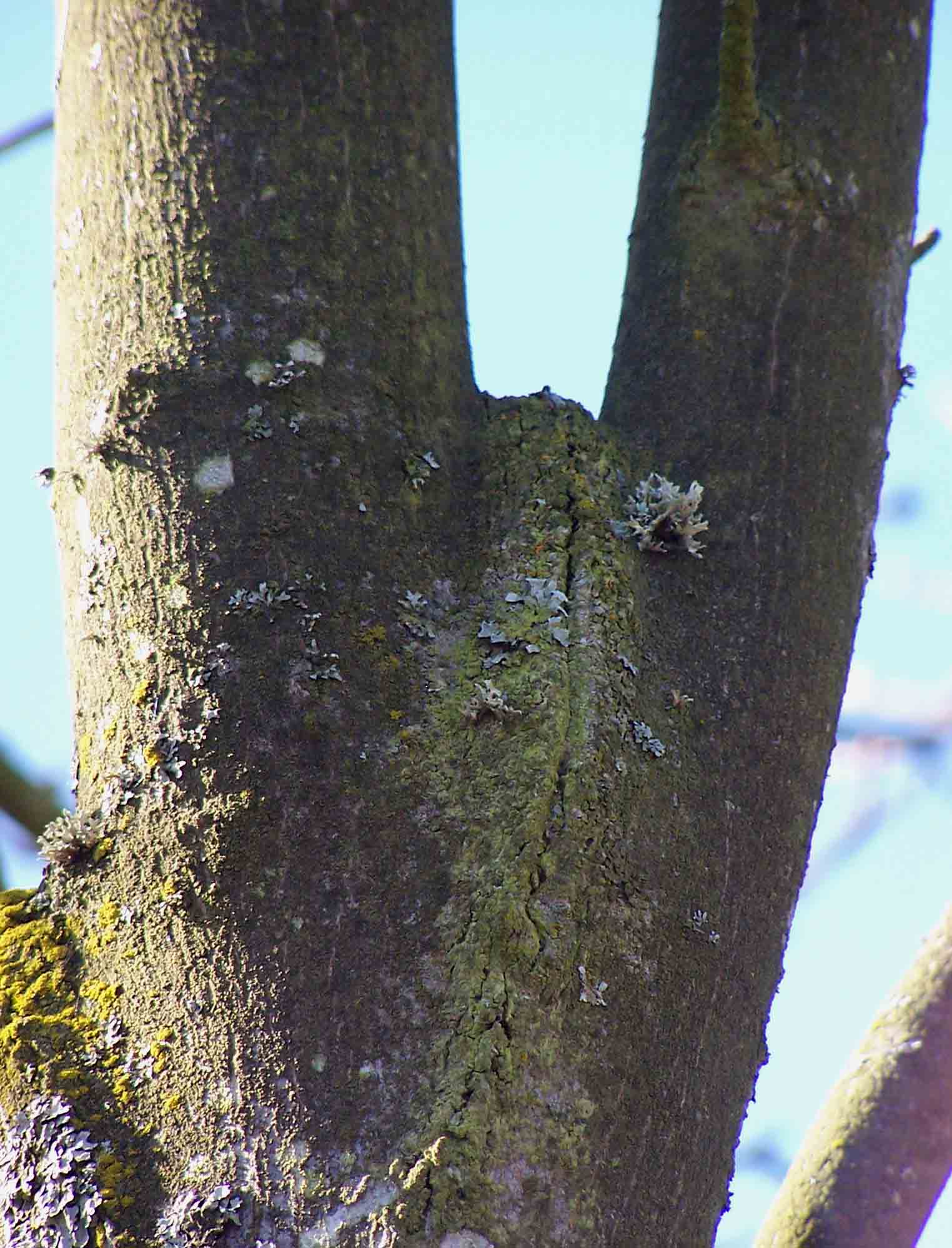

What effect do bark inclusions have on the trees? These fused branches are not strongly connected; in fact, they are likely points of branch failure. As these branches become larger and heavier, they can create hazard situations if they are near people or property. What’s happening here in Washington, and probably elsewhere, is that arborists must be hired to prune out some of these branches to reduce the risk of failure and injury.
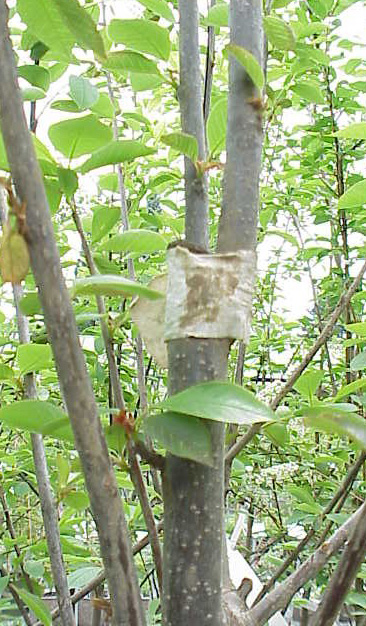
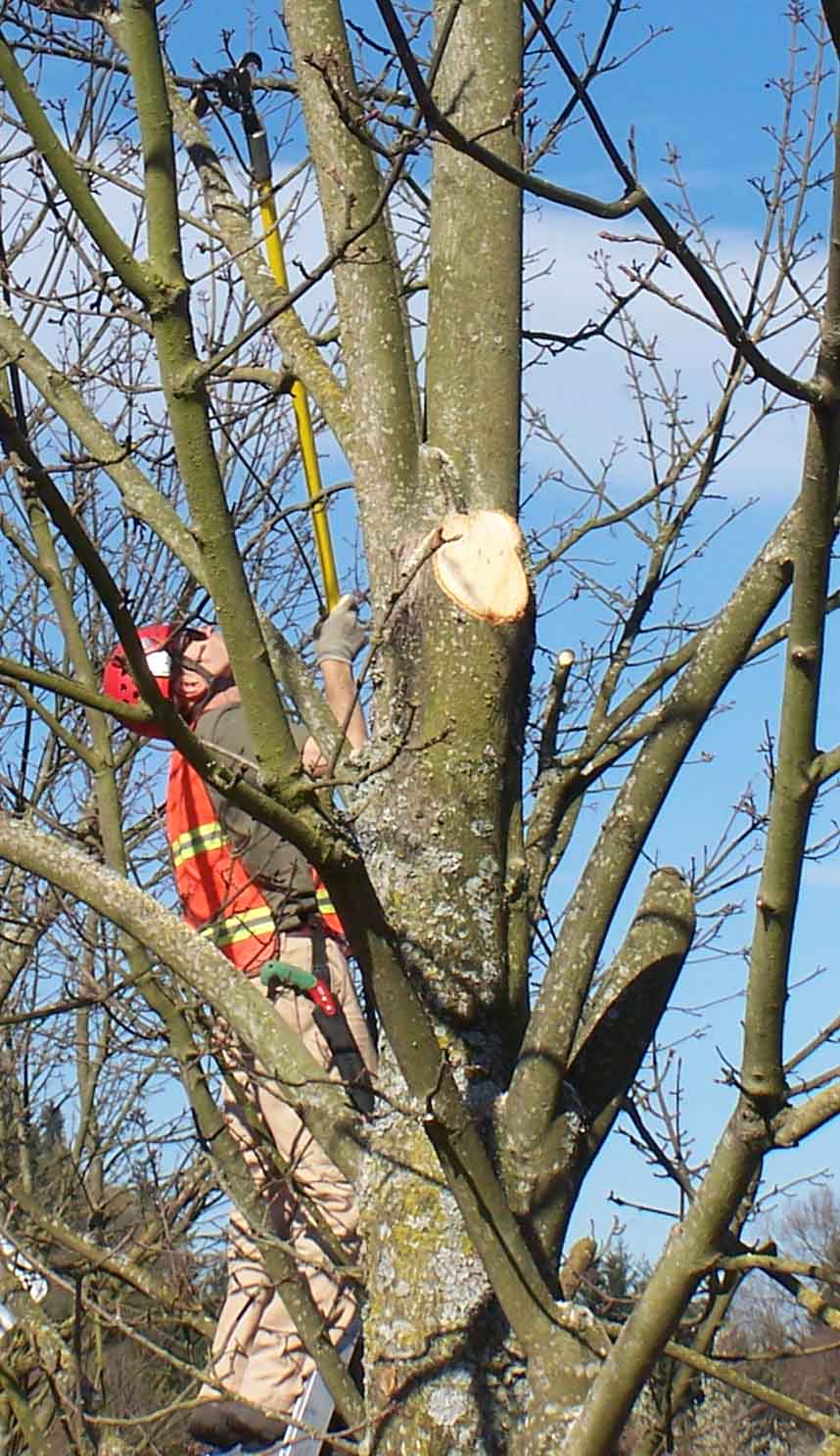
This…most definitely will lead to this…eventually
I can’t understand why this practice is perceived as “building a better tree.” To me, it looks like creating a maintenance and liability problem down the road.
i work at a nursery, and we do a lot of heading back of trees in the winter. this is done not to make the trees look more 'mature' but because otherwise they will grow too big for the container. honestly, sales are slow from the economy so we have a lot of trees not selling and they just get too tall and skinny for their container. then you get a lot of trees toppling over in the wind. –2 cents
Joe, I know sometimes nurseries do head back their stock for practical reasons like this. (Still not a great idea, given how plants respond, but it happens.) The practice in my posting has been promoted as a deliberate way to create trees that have a more narrow crown (which creates the problem I've noted). In terms of your nursery's stock problems – would you be able to de-pot and either heel them in or field plant? It would solve the stability problem and you could pot them up into larger containers (or B&B) the following year and charge more for them?
I see a lot of this practice (though not necessarily simply to make a more columnar tree), and, in fact, we will often head back trees in our nursery to get a straight(er) leader. We track many of our trees that are planted and I work with an urban forester who tracks these trees as well. If it's done properly (which includes cuts to suppress the growth of lateral branches which may compete with the central leader which the grower has chosen), I don't see it causing many problems. Your presupposition that branches around the cut will be stimulated is certainly valid, but if the grower does a good job of selecting and encouraging a leader, I just haven't seen this become a major problem.
I agree with your suppositions about choosing a new leader (which is often necessary, especially if insects, disease or other damage has taken out the original). But this is different. This is creating narrow trees with narrow branch angles for narrow spaces. It is a HUGE issue in Seattle and the surrounding area. I got called out to take the photos of the trees in the last of my pictures because the local arborists are tired of dealing with poor planning and poor production. Believe me – I don't make this stuff up!
The last of your pictures is very telling — I can't believe that someone would tape two potential leaders together — calling it "insane" is being too kind! Speaking of insane — Tomorrow I'm going to post pics of the worst nursery ever — I hope you enjoy it!
Whoo hoo! I always tell people to approach nurseries like day cares – are the plants happy and healthy, or neglected and crying? Can't wait to see what you've got!
And I meant the last comment in the most professional way possible.
Agreed – it's lunacy. But as Jeff said, with proper management, this practice doesn't have to lead to future problems. The problem is, I suppose, a lack of resources and skills amongst urban tree managers. Getting your horticulture right can not only save you future issues – the this one – but save you money as well. I look forward to the 'worst nursery ever' post that's coming! Regards, Jimbo.
Out of curiosity predominately, what species are you seeing this practice done which are the most troublesome? Or are some just being bred this way?
I agree trying to shoehorn something that's going to become large into a tight space isn't necessarily a great idea but obviously the growers wouldn't be doing this if the demand from (private, commercial & municipal)wasn't there.
I'm from the midwest and well remember the issues with the Bradford Pears – weak branch angles, short lifespan not a safe combination. But it was very popular.
I'm thinking that there is contractor demand for these "slim" trees. My husband and I are looking for a new construction house, and have seen several with dogwoods, birches, and maples planted 6-12 inches away from the foundation to make the landscaping look proportional to the size of the house. When I point out to my husband that this will become a problem, his response is, "well you'll take care of that, right?" Real nice of him!
SJ, I'm not sure which species in particular are being trained this way (the growers are out of state). Those that I have photos of are all different. I'm guessing it would be those species that are listed in specs as acceptable street trees. Past that, I'm in the dark…
Shira, you can bet there is a demand for these trees. Lot sizes keep shrinking but house size doesn't, so the space left over for trees is less and less.
This whole scenario just doesn't add up right for me…
I work as the nursery manager for a small independent garden center in the mid-west. I get trees shipped in from several dozen different growers, nationwide. Nearly all of them train young trees by removing the leader each growing season, and taping up a lateral. This is not done to make "narrow" trees, but to encourage heavier lateral branching, so that apical dominance is restrained and you don't get a "beanpole" tree 8' tall and 6" wide.
This is an industry-wide practice – shoot, JF Schmidt in Oregon ships out about a gajillion trees a year with this kind of training. Nobody in the industry sees such growing technique as a problem.
Now, if growers in Washington are actually topping trees so they can be sold as narrow, columnar forms suitable for small urban spaces, then yes, that is a problem. If landscape architects and urban planners are actually accepting these trees because of space restraints, then that too is a real problem. Those folks often don't know as much about plants as a working horticulturist – but really, they do know to spec a Bowhall maple or fastigate English oak when they need a narrow tree!
Believe me, I've seen my share of poorly grown trees over the years. But I find it hard to fathom that the state of Washington is filled with unscrupulous nursery growers and clueless urban foresters.
Or perhaps I have mis-understood the conclusions of Linda's post?
Brian, Very interesting point. Many of the nurseries that I work with do exactly what you indicate without problems. Based on the picture at the end of this post, it looks like two potential leaders were taped together without any suppressing cuts. Now, if one of these leaders is cut out later in the season (which would be standard operating procedure for some nurseries) then I don't see an issue with the practice in the picture. But if one of the branches isn't removed — which I think is what Linda is indicating will happen — then I think there is a problem here. I agree that it seems odd than many nurseries would do this — we certainly don't see it commonly here in Minnesota. As you indicate, most people have the good sense to purchase trees that are naturally fastigate.
For the most part, the trees we get are from large, out-of-state production nurseries – and I'm not the only one that complains about it. Many ISA-certified arborists have noted this, both in Washington State and elsewhere. (One horticulture student who used to work at a large production nursery told me all the trees there were topped prior to shipping to keep them at manageable heights!) Regardless of why they are topped and trained (or not), the fact remains that when large species mature all of those acutely angled branches fuse together and create bark inclusions. The result is that city foresters have to go in and fix these problems where there are hazards to property or people. The one I showed in the blog was from Mercer Island, and I was told that these trees (I showed one of dozens) had been deliberately topped and trained as saplings to form unnaturally columnar forms. I can't agree that this is a good practice with species that reach any height and girth. (I wish more of the ISA arborists who read this blog would leap in about now!)
Good post! This isn't an issue I've seen here in MA, but I have seen lots and lots of woody plants coming in that have been tightly pruned — not sheared, but tipped back all over to promote denser growth. When I do a design, I'm envisioning the natural form of a particular species, and find that my new plants have to grow out of the lollipoppish shapes they've been pruned into before that natural form can reassert itself. Maybe they're pruned that way in the nursery for greater uniformity, or to keep them smaller for a year? The results can be a little peculiar.
Indeed they can, Deb! I can't help but remember the line from The Little Prince: "You become responsible, forever, for what you have tamed." A tree or shrub that's been pruned into a form that's not natural will require constant pruning to maintain that form.
The lollipopping of trees only adds foliar growth, too, and adds diameter to those limbs growing from poorly structured crotches — which means that structural pruning corrections after planting tends to make bigger wounds. The structural pruning that removes narrow angles earlier in the game is better for the end result (the tree planted and growing well, in a designed landscape) than the apparently cosmetic tactic of tipping back to make uniform tree outlines to make a tree look 'healthy'.
Am I missing the reasons for tipping back trees all over like this?
I'm hoping my colleagues affiliated with the production side of things might have an answer? Those of us on the maintenance/management side don't get it!
topping, or cutting the tips off of multiple branches is a bad way to go. It's not common — where we usually see it is from a retailer who decides to make the young tree look more lollipop like — unfortunately people are too gullible. I only saw a wholesaler do this once.
One significant factor may likely be that each plant is a production unit. As such, each unit should resemble every other unit as closely as possible in size and condition; in a given block of, say, 2.5” caliper kousa dogwoods, all the dogwoods will be priced the same. For cultivating, digging, moving, and selling, it makes sense to have each tree crown as similar in form and appearance to all the others. Variation makes pricing and selling more difficult; a controlled uniformity, even if it make compromise a tree’s structure further down the road, preserves the tree’s value to the nursery as a unit on the ledger.
Sad but true. How nice it would be if plants were seen as living components rather than design elements.